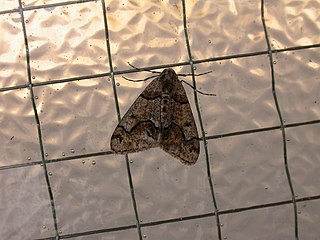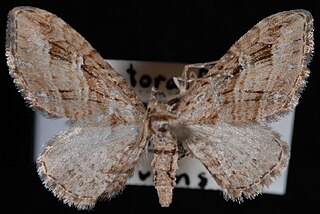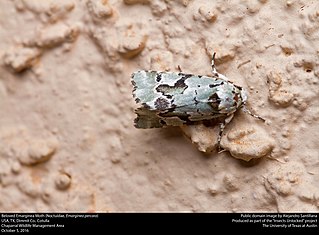
Apatelodidae, the American silkworm moths, is a family of insects in the order Lepidoptera. They are a family within the superfamily Bombycoidea, though they have in the past been considered a subfamily of Bombycidae.

Omiodes is a moth genus in the family Crambidae. Several species are endemic to Hawaii.

Cisthene is a genus of lichen moths in the family Erebidae. The genus was erected by Francis Walker in 1854.
Amiana is a monotypic moth genus of the family Noctuidae. Its only species, Amiana niama, is found in the US state of Arizona. Both the genus and species were first described by Harrison Gray Dyar Jr. in 1904.

Dichagyris is a genus of moths of the family Noctuidae. The former genera Loxagrotis, Pseudorichia, Pseudorthosia and Mesembragrotis are now considered subgenera of Dichagyris. From Greek dikha-gyris 'apart, asunder; double' + 'the finest meal or flour'; English pronunciation: /digh-kuh-JIGH-riss/, IPA [dɑj•kə'dʒɑj•ɹɪs].

Lobophora magnoliatoidata is a moth of the family Geometridae first described by Harrison Gray Dyar Jr. in 1904. It is found in western North America in Alberta, British Columbia, Yukon, the Northwest Territories, south through Washington to California.

Sympistis subsimplex is a moth of the family Noctuidae first described by Harrison Gray Dyar Jr. in 1904. It is found in North America, including Arizona.

Harrison Gray Dyar Jr. was an American entomologist. Dyar's Law, a pattern of geometric progression in the growth of insect parts, is named after him. He was also noted for eccentric pursuits which included digging tunnels under his home. He had a complicated personal life and along with his second wife he adopted the Baháʼí Faith.

Actrix nyssaecolella, the tupelo leaffolder moth, is a species of moth of the family Pyralidae described by Harrison Gray Dyar Jr. in 1904. It is found from Michigan and New York to Florida and west to Texas.

Gabriola dyari, or Dyar's looper, is a moth of the family Geometridae first described by Taylor in 1904. It is found from the Alaskan panhandle and British Columbia to California. The habitat consists of coniferous forests.
Eupithecia casloata is a moth in the family Geometridae first described by Harrison Gray Dyar Jr. in 1904. It is found in North America, including Yukon, British Columbia, Alberta, Saskatchewan, New Brunswick, Newfoundland and Labrador, Quebec, Washington, Montana, Oregon, Wyoming, Colorado, Utah, California, Maine and New Hampshire.

Eupithecia niphadophilata is a moth in the family Geometridae first described by Harrison Gray Dyar Jr. in 1904. It is found in North America from British Columbia and western Alberta south to New Mexico.

Apatelodes is a genus of moths of the family Apatelodidae first described by Packard in 1864.
Apatelodes adrastia is a moth in the family Apatelodidae first described by Herbert Druce in 1887. It is found in Mexico, Costa Rica and Panama.
Apatelodes ardeola is a moth in the family Apatelodidae first described by Herbert Druce in 1887. It is found from the Mexican state of Tabasco and Panama to the Amazon region.

Apatelodes firmiana is a moth in the family Apatelodidae first described by Caspar Stoll in 1782. It is found from Mexico to Guyana

Apatelodes heptaloba is a moth in the family Apatelodidae first described by Herbert Druce in 1887. It is found in Guatemala.
Scoparia normalis is a moth in the family Crambidae. It was described by Harrison Gray Dyar Jr. in 1904. It has been recorded from the US states of Arizona, Colorado, New Mexico, North Carolina and Utah.

Psaphidini is a tribe of owlet moths in the family Noctuidae. There are at least 40 genera and at least 90 described species in Psaphidini.

Peoria is a genus of moths of the snout moth family (Pyralidae). The genus was erected by Émile Louis Ragonot in 1887.














